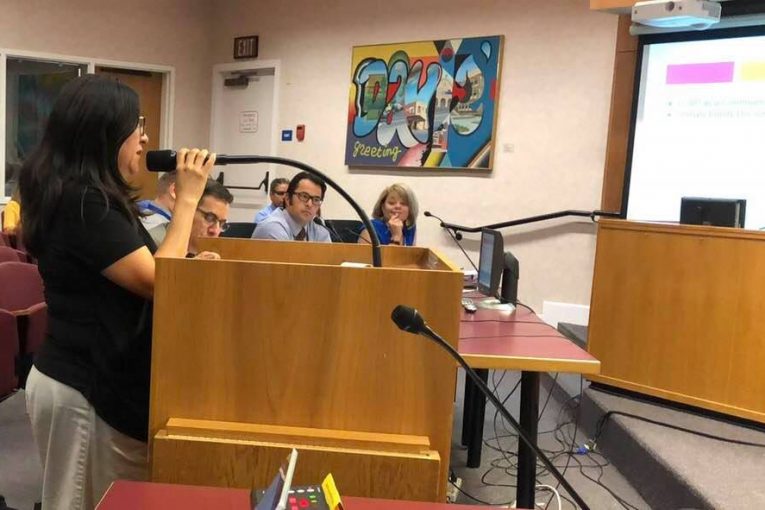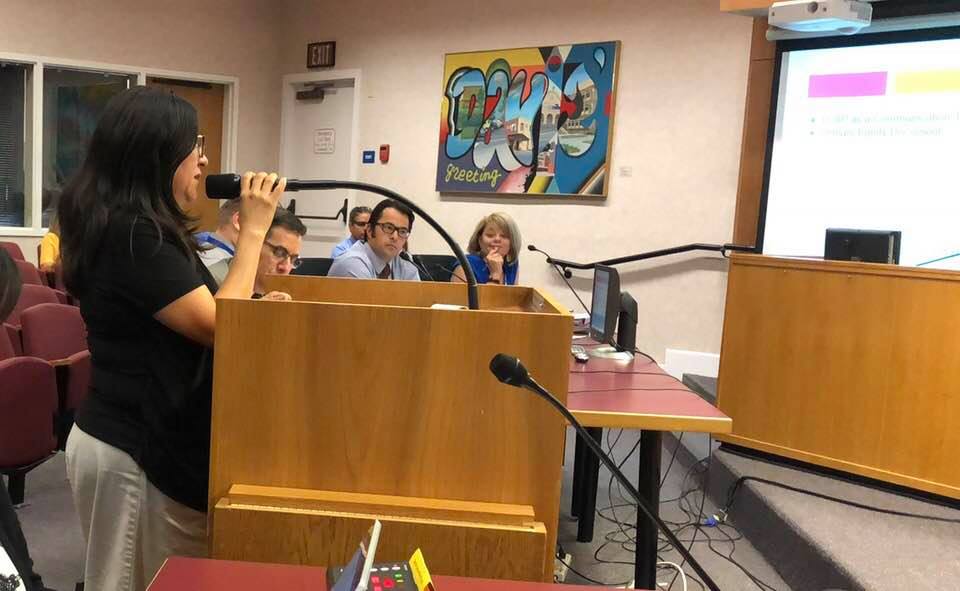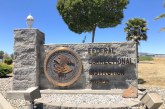

Last week Melissa Moreno, speaking as a parent and community member, was watching the DJUSD discussion of the LCAP (Local Control and Accountability Plan). She became concerned when a slide placed “equity constituent focus” on African American and Native American students, but not on Hispanic and Latino students.
In a follow up email she told the Vanguard, “I did not intend to make a public comment of any sort. But, I was compelled to make it after noticing the slide that indicated ‘equity constituent’ focused on ‘African American and Native American.’ It seemed to overlook Chicana/o Latina/o students as an equity constituent and seem to assumed that all are EL students.”
She added, “I was surprised that there was no mention of Ethnic Studies in the LCAP plan, once again.”
LCAP in part attempts to deal with and remedy the achievement gap. Among the goals cited by the local district are the need for educators to help close the achievement gap, as well as have classrooms and school communities create what they call “safe and inclusive environments.”
For Melissa Moreno, a key component of this is creating an Ethnic Studies program – that is something that goes beyond the course offerings currently offered by the district.
As Associate Superintendent Rody Boonchouy pointed out on Thursday, the district does have an offering of Race and Social Justice that students can take in the place of English 11.
Mr. Boonchouy noted the evolution of the Race and Social Justice class over the last 10 to 15 years has been that the growth of the class has taken it into a majority status as opposed to other US History courses.
He said, “It’s an interesting lesson for us on the trajectory of the introduction of a new course.”
As some have suggested, the RSJ course also covered required material for US History but with the added focus on issues of race and social justice during that era.
Still, one course does not cover the needs of students of color who often find themselves behind their white and Asian peers in tests that measure the pervasive achievement gap.
Professor Moreno told the Vanguard, “There had been interest and conversations since 2017 among several parents and community members about Ethnic Studies.”
She described a meeting from April 2018 that she and Cecilia Escamilla Greenwald had with DJUSD leadership at the district offices to discuss Ethnic Studies.
Melissa Moreno said, “At the meeting we discussed Ethnic Studies and how it could address all the aspects of the graduate profile. We were told that that district would consider it when preparing their LCAP annual plan.”
At the time they told her, “They did not consider it in last year’s LCAP plan” and she said that on Thursday “at the board meeting I noticed that the district did not consider it again.”
On Thursday, Rody Boonchuouy explained, “During that meeting we had a request around ethnic studies, the value of it, the reason why its important.”
He said, “Our values are deeply aligned.” But he said, “The challenge is trying to figure out the logistics of introducing a new course of study and what that would look like in making sure that (we) do it in a sustainable manner… particularly with enrollment the way it is.”
He asked, “How would we introduce? At the expense of what? And the process by which we would get there.”
Board President Bob Poppenga perhaps offered a way forward, “Ethnic studies should be embedded into our existing courses, and not have to stand alone.”
For Melissa Moreno that seemed like a good approach, and she “appreciated some of the questions of the Trustees. I especially valued the DJUSD President’s question about whether Ethnic Studies (should) be integrated throughout the curriculum.”
She added, “Indeed, this is what some schools have done; they have it in English, History/SS, Art, and have even created Ethnic Studies math courses called ‘Am I an Ethnic Statistic’ and ‘Mathematics and Social Justice.’ In the case of WJUSD, they have six different courses.”
In a separate conversation with the Vanguard, she noted that Woodland was well ahead of where Davis is on ethnic studies offerings, as is the state of California.
Of particular note is the current proposal of AB 331, introduced in January by Assemblymember Jose Medina. AB 331 would mandate Ethnic Studies as a graduation requirement in all California high schools.
The proposal follows up on AB 2772, vetoed by Governor Jerry Brown, which would have created a pilot program for select school districts to require Ethnic Studies.
“Knowledge of our history plays a critical role in shaping who we become. When I was growing up, the history of those who look like me was not represented in the classroom. As a former Ethnic Studies teacher, I saw firsthand how much more engaged my students were when they saw themselves reflected in the coursework,” Assemblymember Medina said in a statement in January.
He added, “Ethnic Studies provide students an opportunity to learn about histories outside of the Euro-centric teachings most prominent in our schools. At a time when the national climate drives divisiveness and fear of otherness, Ethnic Studies can play a critical role in increasing awareness and understanding.”
Melissa Moreno told the Vanguard that there are over 30 school districts in California that have either passed Ethnic Studies resolutions and/or made Ethnic Studies a graduation requirement. That includes Woodland Joint Unified.
In addition to AB 331, there is also AB 1460 which would make Ethnic Studies a required course at the CSU campuses.
She believes, “LCAP school funding can be used to support Ethnic Studies, and we have several Ethnic Studies trained parents and folks in town.”
But, despite claims of support and valued alignment from both board and administration, Melissa Moreno was also troubled by things she heard on Thursday by board members.
She said, “Some of the responses to the Trustees questions however seem troubling. They referred to (1) difficulties of cutting something for Ethnic Studies, (2) that the existing Race and Social Justice course sections already addresses the Ethnic Studies need, and (3) that promises have been made to the Native students/families.”
She argued: “All these three responses can be unpacked and have solutions that other districts have used.”
Rody Boonchouy noted they have a new social studies framework that has “in deep and significant ways raised issues of cultural awareness of historical eras and experiences, perspectives, or perspectives that have forever not been acknowledged or recognized which why are a fan of the revisions to that framework.”
He added, they are not their own courses but “we’re seeing that integration much more clearly now.”
Ms. Moreno told the Vanguard, “I think that it’s important for our DJUSD leaders and Trustees to understand that Ethnic Studies is for the academics and social emotion of all students and community. The research, goals, metrics and actions/services (courses), and service learning already exist to support the effectiveness of Ethnic Studies. “
—David M. Greenwald reporting







You go Melissa! Don’t settle for lip service from DJUSD.
“In a separate conversation with the Vanguard, she noted that Woodland was well ahead of where Davis is on ethnic studies offerings as is the state of California.”
We’re number 2.
I wonder if Woodland has a narrower achievement gap than Davis?
Note the demographics of DJU. Despite having as many Asian students as Hispanic DJU has numerous Hispanic programs and, to my knowledge, nothing for Asians.
White
53%
Hispanic
20.2%
Asian
17.5%
Multiracial
5.8%
African American
2.8%
Native American
0.4%
Pacific Islander
0.3%
Thank you Jim for the stats… would have guessed wrong on the %-ages, big time…
Yet, I think the point of the concerns some have expressed, here, and elsewhere, is that too much of the curriculum focuses on white male (sometimes female) contributions [generally both heterosexual], and not enough on ethnic minorities and LGBT+++ folk.
Ethnic studies are issue du jour… sexual orientation issues/studies next? Time will tell…
Wondering what contributions are being referred to, and why/how the characteristics of the individual contributor even come up. Do they introduce subjects by saying, “here’s what (fill-in-the-blank)” contributed, and take note of his/her characteristics?
How does this help with the focus on STEM, for example? Do they even discuss individual contributors in these subjects very often? Or, do they primarily focus on the subject matter, itself?
There is a certain level of ignorance is saying you want to get away from Euro-Centric and instead emphasize “Hispanic” given it is defined as “relating to Spain”.
Ron… your questions would best be addressed to educators with “boots on the ground”… not me…
Jim Hoch: “Despite having as many Asian students as Hispanic DJU has numerous Hispanic programs and, to my knowledge, nothing for Asians.”
What do you imagine would be available in your ideal world?
Some acknowledgement they exist would be nice. Certainly it is widely believed that the previous Board of Trustee’s war on AIM was inspired by the numbers of Asians in it. I have found no reason to doubt that.
“Facts”, and I do mean “facts”, not in evidence… may be true, but at this point, rumor and those who would ‘promote’ that conspiracy theory… wonder what the ethnic background of those espousing that theory/supposition are…
Possibly the ‘Asian’ community… or those related (blood/marriage) to them, whose kids were getting into AIM, and saw program ‘losses’ that they perceived to affect them? Another possibility was/is folk of any stripe who felt “their” group was being ‘dissed’? After all, AIM qualification is unjust unless it either perfectly reflects ethnic percentages, or leans to the “under-represented” to atone for past practices… right?
Jim, I believe your 1:03 post is a ‘red herring’… I could be mistaken…
“A red herring is something that misleads or distracts from a relevant or important question. It may be either a logical fallacy or a literary device that leads readers or audiences toward a false conclusion.”
How was my comment a “red herring”. I believe the topic was Asians in DJU?
“I believe the topic was Asians in DJU?”
The AIM program should be regarded as a program for “Asian” students?
your first topic in the thread was “Despite having as many Asian students as Hispanic DJU has numerous Hispanic programs and, to my knowledge, nothing for Asians.”
No “refuses to say”?
No Jews?
Add, “don’t know, don’t care, not important”?… alternate answer, “Person”?… very precious, without other adjectives/definitions…
Just a thought…
I’ve never understood how ethnic study courses help narrow an “achievement gap” – however that’s defined. If there’s a gap in “achievement”, shouldn’t courses be focused on that instead?
In support of this statement, aren’t there already existing funding challenges at DJUSD?
Thought: find your HS text book on history and count the number of non-white and female figures in it. Then let’s talk.
So, you’re referring only to history courses. Things were already changing when I was in high school.
I recall that issues such as the impact of California Missions on Native American populations were already acknowledged and taught, back then. As well as the impact on native populations in South America, as a result of Spanish “expansion”.
As was the impact of other Europeans, on native populations.
What that has to do with subjects such as STEM, as well as the “other” E (English) has not been explained. (I assume these subjects are where the achievement gap lies – not in ethnic studies.)
I’m wondering at what point the “achievement gap” (and overall impact on Davis schools) might help bridge the “state funding gap”.